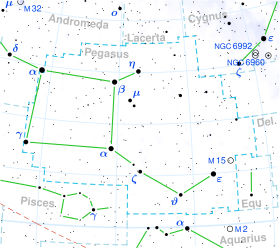Star in the constellation Pegasus
32 Pegasi
Observation dataEpoch J2000 Equinox J2000
Constellation
Pegasus
Right ascension
22 21 19.33896
Declination
28° 19′ 49.8786″
Apparent magnitude (V)
4.81 (4.83 + 8.86)
Characteristics
Spectral type
B9III
U−B color index
−0.19
B−V color index
+0.00
Astrometry Radial velocity (Rv )+11.40 km/s Proper motion (μ) RA: +17.426 mas /yr Dec.: +7.122 mas /yr Parallax (π)5.7814 ± 0.3196 mas Distance 560 ± 30 ly pc ) Absolute magnitude (MV )−1.82 Details 32 Peg Aa Luminosity 541 L ☉ Temperature 11,403 K Rotational velocity (v sin i )60 km/s Other designations 32 Peg , BD +27°4299, GC 31253, HD 212097, HIP 110371, HR 8522, SAO 90440, CCDM J22213+2820AF, WDS J22213+2820Aa,Ab Database references SIMBAD data
32 Pegasi is a binary star system in the northern constellation of Pegasus . It is visible to the naked eye as a faint, blue-white hued point of light with an apparent visual magnitude of 4.81 The system is located approximately 560 light years away from the Sun based on parallax , and is drifting further away with a radial velocity of +11.4 km/s.
The brighter member of this system, designated component Aa, has visual magnitude 4.83 with a stellar classification of B9III, matching a late B-type star with the luminosity class of a giant . It is spinning with a projected rotational velocity of 60 km/s, and is radiating 541 times the luminosity of the Sun from its photosphere at an effective temperature of 11,403 K.
The fainter secondary, component Ab, is of magnitude 8.86 with an angular separation of 0.50″ along a position angle of 288° from the primary, as of 2005. Visual companions include component B, at a 70.7″ separation from the primary and magnitude 10.73; C, at a separation from B of 3.2″ and magnitude 12.4; as well as D (separation from A of 42.8″ and magnitude 11.9) and E (separation from A of 58.3" and magnitude 11.9).
References
^ Brown, A. G. A. ; et al. (Gaia collaboration) (August 2018). "Gaia Data Release 2: Summary of the contents and survey properties" . Astronomy & Astrophysics 616 . A1. arXiv :1804.09365 . Bibcode :2018A&A...616A...1G . doi :10.1051/0004-6361/201833051 .Gaia DR2 record for this source at VizieR .
^ Ducati, J. R. (2002). "VizieR Online Data Catalog: Catalogue of Stellar Photometry in Johnson's 11-color system". CDS/ADC Collection of Electronic Catalogues . 2237 . Bibcode :2002yCat.2237....0D .
^ Mason, Brian D.; Wycoff, Gary L.; Hartkopf, William I.; Douglass, Geoffrey G.; Worley, Charles E. (2001). "The 2001 US Naval Observatory Double Star CD-ROM. I. The Washington Double Star Catalog" . The Astronomical Journal . 122 (6): 3466. Bibcode :2001AJ....122.3466M . doi :10.1086/323920 . Vizier catalog entry
^ Hoffleit, D.; Warren, W. H. (1995). "VizieR Online Data Catalog: Bright Star Catalogue, 5th Revised Ed. (Hoffleit+, 1991)". VizieR On-line Data Catalog: V/50. Originally Published in: 1964BS....C......0H . 5050 . Bibcode :1995yCat.5050....0H .
^ Gontcharov, G. A. (2006). "Pulkovo Compilation of Radial Velocities for 35 495 Hipparcos stars in a common system". Astronomy Letters . 32 (11): 759–771. arXiv :1606.08053 . Bibcode :2006AstL...32..759G . doi :10.1134/S1063773706110065 . S2CID 119231169 .
^ Anderson, E.; Francis, Ch. (2012). "XHIP: An extended hipparcos compilation". Astronomy Letters . 38 (5): 331. arXiv :1108.4971 . Bibcode :2012AstL...38..331A . doi :10.1134/S1063773712050015 . S2CID 119257644 . Vizier catalog entry
^ Paunzen, E.; Schnell, A.; Maitzen, H. M. (2005). "An empirical temperature calibration for the Δa photometric system". Astronomy and Astrophysics . 444 (3): 941. arXiv :astro-ph/0509049 . Bibcode :2005A&A...444..941P . doi :10.1051/0004-6361:20053546 . S2CID 119436374 .
^ Abt, Helmut A.; Levato, Hugo; Grosso, Monica (2002). "Rotational Velocities of B Stars" . The Astrophysical Journal . 573 (1): 359–365. Bibcode :2002ApJ...573..359A . doi :10.1086/340590 .
"32 Peg" . SIMBAD Centre de données astronomiques de Strasbourg . Retrieved 2019-07-01.Eggleton, P. P.; Tokovinin, A. A. (2008). "A catalogue of multiplicity among bright stellar systems" . Monthly Notices of the Royal Astronomical Society . 389 (2): 869. arXiv :0806.2878 . Bibcode :2008MNRAS.389..869E . doi :10.1111/j.1365-2966.2008.13596.x . S2CID 14878976 . Vizier catalog entry
Categories :
Text is available under the Creative Commons Attribution-ShareAlike License. Additional terms may apply.
**DISCLAIMER** We are not affiliated with Wikipedia, and Cloudflare.
The information presented on this site is for general informational purposes only and does not constitute medical advice.
You should always have a personal consultation with a healthcare professional before making changes to your diet, medication, or exercise routine.
AI helps with the correspondence in our chat.
We participate in an affiliate program. If you buy something through a link, we may earn a commission 💕
↑
